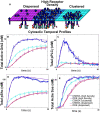Coupled stochastic spatial and non-spatial simulations of ErbB1 signaling pathways demonstrate the importance of spatial organization in signal transduction
- PMID: 19626123
- PMCID: PMC2710010
- DOI: 10.1371/journal.pone.0006316
Coupled stochastic spatial and non-spatial simulations of ErbB1 signaling pathways demonstrate the importance of spatial organization in signal transduction
Abstract
Background: The ErbB family of receptors activates intracellular signaling pathways that control cellular proliferation, growth, differentiation and apoptosis. Given these central roles, it is not surprising that overexpression of the ErbB receptors is often associated with carcinogenesis. Therefore, extensive laboratory studies have been devoted to understanding the signaling events associated with ErbB activation.
Methodology/principal findings: Systems biology has contributed significantly to our current understanding of ErbB signaling networks. However, although computational models have grown in complexity over the years, little work has been done to consider the spatial-temporal dynamics of receptor interactions and to evaluate how spatial organization of membrane receptors influences signaling transduction. Herein, we explore the impact of spatial organization of the epidermal growth factor receptor (ErbB1/EGFR) on the initiation of downstream signaling. We describe the development of an algorithm that couples a spatial stochastic model of membrane receptors with a nonspatial stochastic model of the reactions and interactions in the cytosol. This novel algorithm provides a computationally efficient method to evaluate the effects of spatial heterogeneity on the coupling of receptors to cytosolic signaling partners.
Conclusions/significance: Mathematical models of signal transduction rarely consider the contributions of spatial organization due to high computational costs. A hybrid stochastic approach simplifies analyses of the spatio-temporal aspects of cell signaling and, as an example, demonstrates that receptor clustering contributes significantly to the efficiency of signal propagation from ligand-engaged growth factor receptors.
Conflict of interest statement
Figures







References
-
- Linggi B, Carpenter G. ErbB receptors: new insights on mechanisms and biology. Trends Cell Biol. 2006;16:649–656. - PubMed
-
- Yarden Y, Sliwkowski MX. Untangling the ErbB signalling network. Nat Rev Mol Cell Biol. 2001;2:127–137. - PubMed
-
- Britten CD. Targeting ErbB receptor signaling: a pan-ErbB approach to cancer. Mol Cancer Ther. 2004;3:1335–1342. - PubMed
-
- Hynes NE, Lane HA. ERBB receptors and cancer: the complexity of targeted inhibitors. Nat Rev Cancer. 2005;5:341–354. - PubMed
Publication types
MeSH terms
Substances
LinkOut - more resources
Full Text Sources
Research Materials
Miscellaneous

